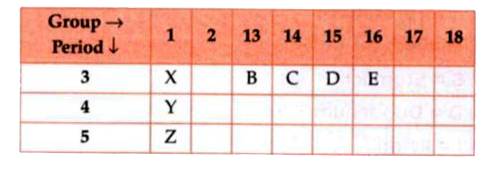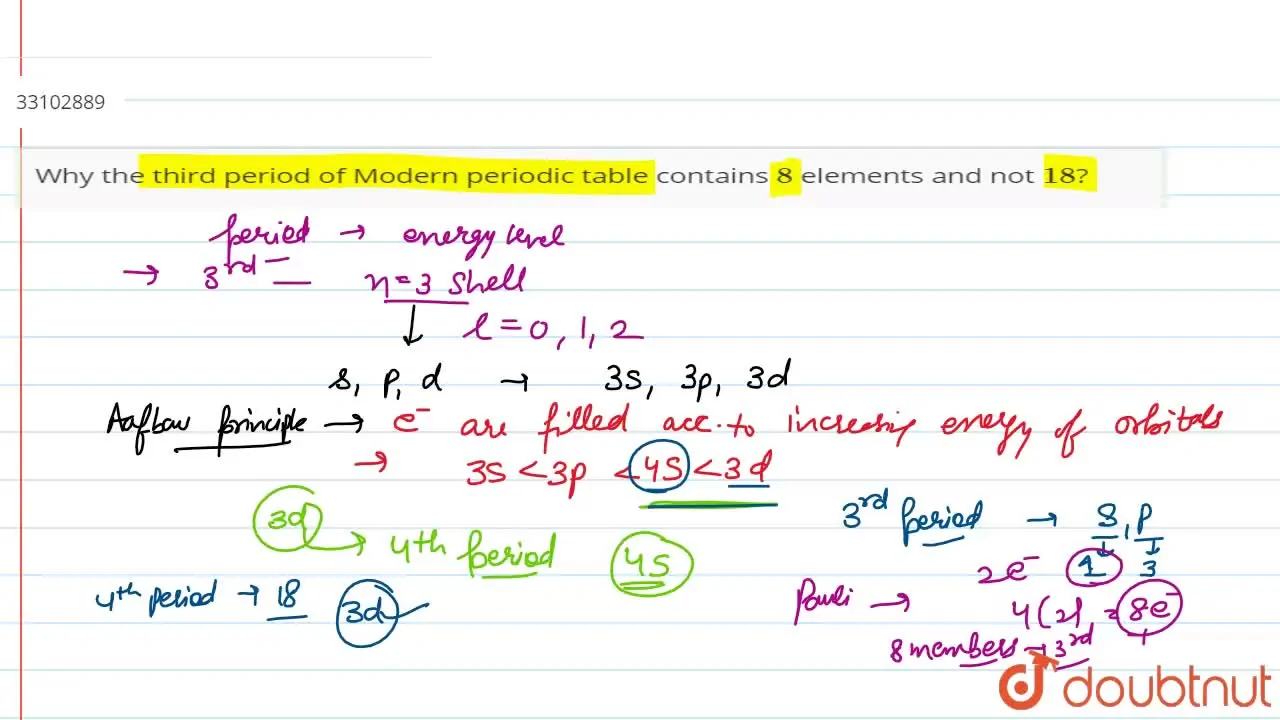Why the third period of Modern periodic table contains 8 elements and not 18?
The correct Answer is:In the modern periodic table, each period starts with the filling of a new principal energy level. Thus, the third period begins with the filling of principal quantum number n=3. When n=3,l=0,1,2. But according to Aufbau principle, the electrons are added to different orbitals in order of their increasing energies. Now, the energy pf 3d-subshell is higher than that of 4s-subshell. Therefore, in third period, electrons can be filled in only 3s & 3p-subshells, whose energies increase in the other : 3s<3p. Now, s-subshell has one and p-subshell has three orbitals. Hence, in all there are 4(1+3) orbitals that can be filled in this period. Since according to Pauli's exclusion principle, each orbital, at the maximum can accommodate two electron, Therefore, 4 orbitals, at the maximum, can have 8 electrons and hence, fourth period has 8 elements.
In the modern periodic table, each period starts with the filling of a new principal energy level. Thus, the third period begins with the filling of principal quantum number n=3. When n=3,l=0,1,2. But according to Aufbau principle, the electrons are added to different orbitals in order of their increasing energies. Now, the energy pf 3d-subshell is higher than that of 4s-subshell. Therefore, in third period, electrons can be filled in only 3s & 3p-subshells, whose energies increase in the other : 3s<3p. Now, s-subshell has one and p-subshell has three orbitals. Hence, in all there are 4(1+3) orbitals that can be filled in this period. Since according to Pauli's exclusion principle, each orbital, at the maximum can accommodate two electron, Therefore, 4 orbitals, at the maximum, can have 8 electrons and hence, fourth period has 8 elements.
Related Playlists
- BOOK - RESONANCECHAPTER - PERIODIC TABLE & PERIODICITYEXERCISE - Exercise-31videos
PERIODIC TABLE & PERIODICITY
- BOOK - RESONANCECHAPTER - PERIODIC TABLE & PERIODICITYEXERCISE - Advanced Level Problems107videos
PERIODIC TABLE & PERIODICITY
- BOOK - RESONANCECHAPTER - PERIODIC TABLE & PERIODICITYEXERCISE - Exercise-21videos
PERIODIC TABLE & PERIODICITY
- BOOK - RESONANCECHAPTER - P-BLOCK ELEMENTS (HALOGEN & NOBLE GASES)EXERCISE - APSP PART-322videos
P-BLOCK ELEMENTS (HALOGEN & NOBLE GASES)
- BOOK - RESONANCECHAPTER - QUALITATIVE ANALYSISEXERCISE - INORGANIC CHMISTRY(Qualitative analysis)35videos
QUALITATIVE ANALYSIS
Similar Questions
The third period of periodic table contains
View SolutionThe fourth period of modern periodic table includes:
View SolutionOn the basis of quantum numbers, justify that the fourth period of the Modern periodic table should have 18 elements.
View SolutionWhich period of the periodic table contains maximum number of elements?
View SolutionIn the third period of the periodic table, the element having smallest size is
View Solution(a) Explain why the first period of the modern periodic table has only two elements whereas second period has eight elements
(b) Why do elements in the same group show similar properties but the elements in different groups show different properties?
(c) For each of the following triads, name the element with the characteristics specified below:

(d) State on reason for keeping fluorine and chlorine in the same group of the periodic table.
(e) What are the merits of the moderns periodic table of elements?View SolutionIn the Modern Periodic Table, which period contains 32 elements?
View SolutionModern periodic table has ...... periods.
View SolutionIn the modern periodic table, elements are arranged in
View Solution
The number of period that the modern periodic table has :View Solution


